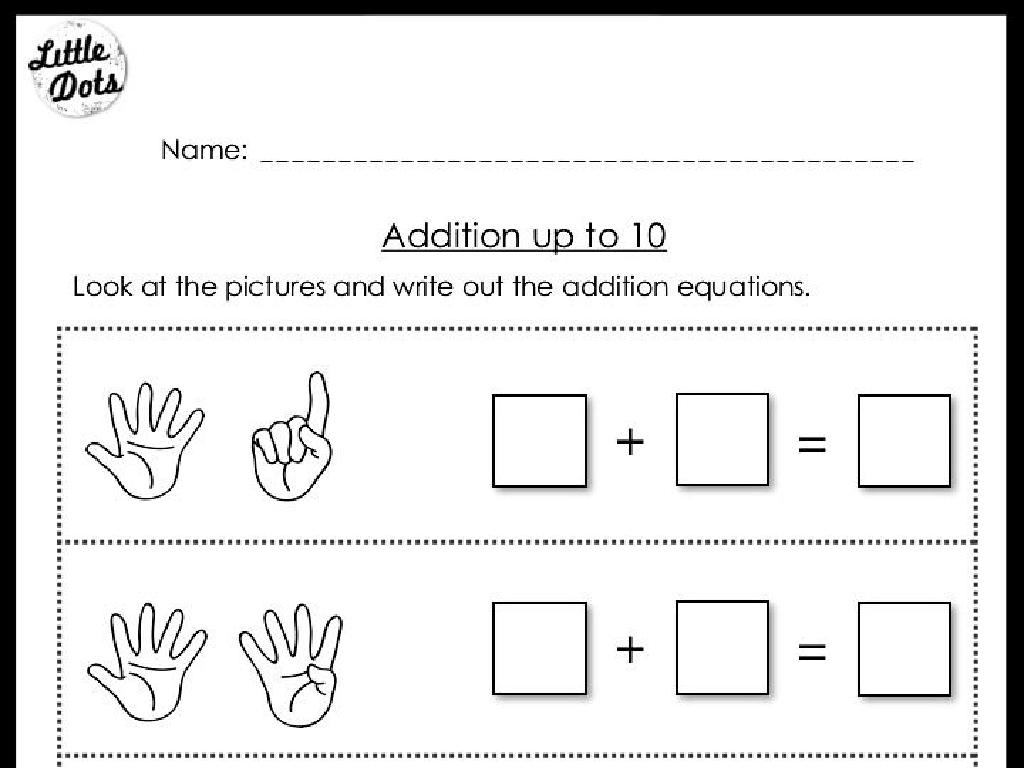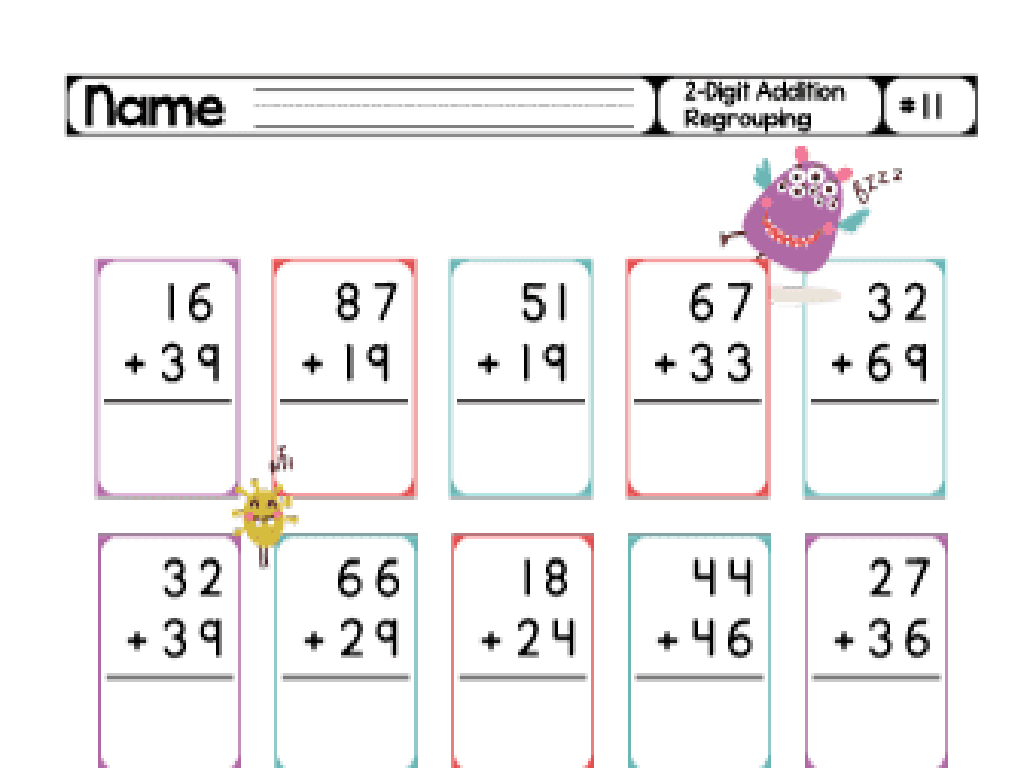Division With Decimal Divisors
Subject: Math
Grade: Sixth grade
Topic: Multiply And Divide Decimals
Please LOG IN to download the presentation. Access is available to registered users only.
View More Content
Division with Decimal Divisors
– Review division with whole numbers
– Division is splitting into equal parts or groups
– Define decimal numbers
– Decimals represent fractions of a whole
– Understand decimal division
– Dividing with decimals extends whole number division
– Importance of decimal division skills
|
Begin with a review of division involving whole numbers to ensure a solid foundation. Explain what decimal numbers are and how they represent parts of a whole, which is a crucial concept for understanding our number system. Emphasize the importance of learning to divide with decimals, as it is a skill that students will use in everyday life, such as in financial literacy, cooking, and science. This understanding is also foundational for higher-level math. Provide examples and plan for practice problems that will help students become comfortable with the process.
Review of Division Basics
– Recap division terms
– Dividend, Divisor, Quotient, Remainder
– Step-by-step division
– Divide, multiply, subtract, bring down
– Simple division examples
– 20 ÷ 4 = 5, no remainder
– Transition to decimals
– Applying basics to decimal division
|
Begin the lesson with a quick review of the key terms in division to ensure students are familiar with the basic vocabulary. Explain the step-by-step process of division, emphasizing the sequence: divide, multiply, subtract, and bring down. Provide examples of simple division problems that students can solve without decimals to reinforce their understanding of the process. This will serve as a foundation for the next lesson where they will apply these steps to division with decimal divisors. Encourage students to ask questions if they’re unsure about any step in the process.
Understanding Decimal Divisors
– Define a decimal divisor
– A number with a decimal point used to divide another number.
– Compare with whole number division
– Similar to whole numbers, but includes dividing by decimals.
– Real-life decimal division examples
– Splitting a bill, measuring ingredients, or dividing money.
– Practice with everyday scenarios
|
This slide introduces the concept of decimal divisors and compares it to division with whole numbers, which students are already familiar with. Emphasize that the process is similar, but they need to pay attention to the placement of the decimal point. Provide real-life examples where decimal division is used, such as when splitting a bill at a restaurant or measuring ingredients in a recipe. This will help students understand the practical application of the concept. Encourage students to think of other everyday scenarios where they might need to divide with decimals. The goal is to make them comfortable with the idea of decimal division before moving on to more complex problems.
Division with Decimal Divisors: Moving the Decimal Point
– Why move the decimal point?
– To simplify division, we make the divisor a whole number by moving the decimal
– Convert decimal to whole number
– Multiply both divisor and dividend by 10 until the divisor is a whole number
– Steps to move the decimal
– Shift the decimal in both numbers the same number of places to the right
– Practice with an example
– Divide 12.5 by 0.25; move the decimal 2 places: 1250 ÷ 25 = 50
|
This slide explains the process of moving the decimal point to simplify division problems with decimal divisors. The goal is to convert the divisor into a whole number, making the division as straightforward as dividing by any other whole number. Students should understand that the same operation must be done to both the divisor and dividend to keep the equation balanced. Provide a step-by-step guide on how to move the decimal and offer a practice problem to solidify their understanding. For the practice problem, demonstrate how moving the decimal two places to the right for both numbers converts 12.5 ÷ 0.25 into 1250 ÷ 25, which equals 50.
Dividing by a Decimal: Step-by-Step
– Steps to divide by a decimal
– Divide a whole number by a decimal
– For example, 25 ÷ 0.5. Move the decimal in 0.5 to make it 5. Now divide 25 by 5.
– Divide a decimal by a decimal
– E.g., 3.75 ÷ 0.25. Make 0.25 into 25, then move the decimal in 3.75 the same spaces.
– Practice with examples
|
This slide introduces the process of dividing by decimals, which is a key concept in 6th-grade math. Start by explaining the steps to divide by a decimal: make the divisor a whole number by moving the decimal point to the right, and do the same with the dividend. Provide clear examples, starting with dividing a whole number by a decimal, and then a decimal by a decimal. Emphasize the importance of aligning the decimal points. Encourage students to practice with additional examples and ensure they understand how to adjust the decimal points correctly. This foundational skill will be crucial for their success in more complex math problems involving decimals.
Common Mistakes in Decimal Division
– Avoid moving the decimal incorrectly
– Always move the decimal to the right end in the divisor
– Place the decimal correctly in quotient
– The decimal in the quotient lines up with the decimal in the dividend
– Watch out for rounding errors
– Round decimals carefully, check the next digit
– Practice with examples to master
|
This slide aims to highlight frequent errors students make when dividing decimals. Emphasize the importance of moving the decimal point in the divisor to the far right to make it a whole number, and ensuring the decimal in the quotient is directly above the decimal in the dividend. Stress the significance of rounding decimals correctly by looking at the digit following the last desired decimal place. Provide ample practice problems where students can apply these tips and solidify their understanding. Encourage students to double-check their work for these common mistakes.
Practice Time: Division with Decimal Divisors
– Let’s solve examples as a class
– We’ll go through problems step-by-step together
– Work on individual practice problems
– Choose problems from the worksheet and try solving them
– Share your solutions with the class
– Be ready to present how you got your answer
– Discuss the answers and methods
– We’ll talk about different ways to reach the solution
|
This slide is designed to engage students in active practice of dividing with decimal divisors. Start with a collaborative class exercise where you solve a few examples together, demonstrating the process step-by-step. Then, allow students to work independently on a set of problems, encouraging them to apply what they’ve learned. Afterward, create a supportive environment where students can share their answers and explain their methods. This will help them learn from each other and understand different approaches to the same problem. As a teacher, facilitate the discussion, correct any misunderstandings, and praise effective strategies. Provide at least 4-5 different types of problems to cater to varying levels of difficulty and ensure that every student is challenged.
Class Activity: Division Relay
– Form teams for relay
– Solve problems with decimal divisors
– Divide numbers like 12.5 ÷ 2.5
– Each member solves a step
– Pass the problem to the next teammate
|
This activity is designed to encourage teamwork and understanding of division with decimal divisors. Divide the class into small groups, and give each team a set of division problems involving decimals. Each student in the team is responsible for solving one step of the division process and then passing the problem to the next teammate to solve the next step. This relay continues until the problem is solved. For example, one student may adjust the divisor and dividend, the next may perform the division without the decimal, and another may place the decimal in the answer. This collaborative approach helps students learn from each other and reinforces the concept of division with decimals. Have four or five different problems ready for each team to ensure that all students get a chance to participate in various steps of the division process.
Wrapping Up: Division with Decimal Divisors
– Review of decimal division concepts
– Practice is key to mastery
– Homework: Decimal Divisors Worksheet
– Solve problems on the provided worksheet to reinforce today’s lesson.
– Bring questions to next class
– Note any difficulties to discuss in our next session.
|
As we conclude today’s lesson on dividing with decimal divisors, it’s crucial to emphasize the importance of practice in mastering this concept. The homework assignment is a worksheet that includes a variety of problems requiring students to apply the methods learned today. Encourage students to attempt all problems and remind them that struggling with a few questions is a natural part of the learning process. They should come to the next class prepared to ask questions and discuss any challenges they faced. This will help solidify their understanding and ensure they are comfortable with the material.






